How to Clean Your Jewelry—and Keep It Sparkling
Updated: Apr. 18, 2024
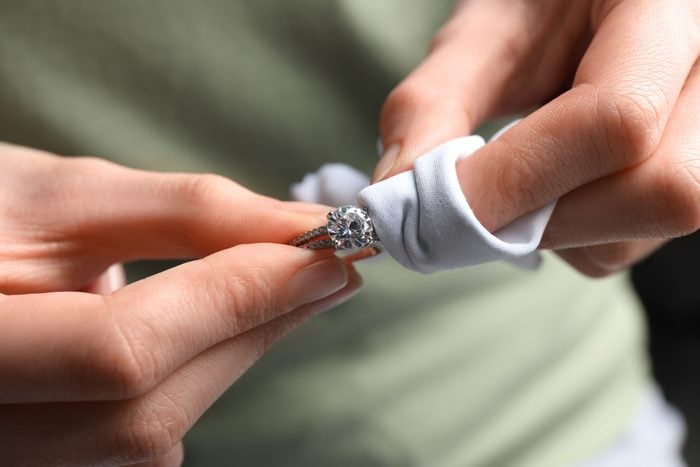
Good news! You can easily clean your jewelry using common household items to keep it shiny and eye-catching.
Wondering how to clean jewelry without breaking the bank? As a cleaning expert with almost two decades of experience who also happens to be jewelry obsessed, I am always looking for ways to make my jewelry look gorgeous. I rarely change out my five tiny gold and diamond earrings, and I notice how grimy and dull they become. Don’t even get me started on my rings; gold and diamonds look cloudy and drab after multiple hand washings and hand cream applications. Whenever I do make time to clean my jewelry pieces, I ask myself why I didn’t do it sooner—because they look dazzling!
In addition to sharing my own tips that I’ve learned as the founder of Clean My Space and a YouTube cleaning expert with more than 2 million subscribers, I’ve tapped Jared Brown, a Toronto-based bespoke jewelry designer, for his top jewelry cleaning advice. We’ll cover how to clean your most treasured necklaces, delicate earrings and diamonds, and gold and silver pieces. I’ve got it all broken down for you here as I cover how to clean jewelry at home with products you already have on hand.
While you’re at it, also discover this hack to get ring off a swollen finger.
About the experts
Reviewed for accuracy by: Ann Russell, TikTok’s “cleaning auntie” and the author of How to Clean Everything. |
How to clean diamonds
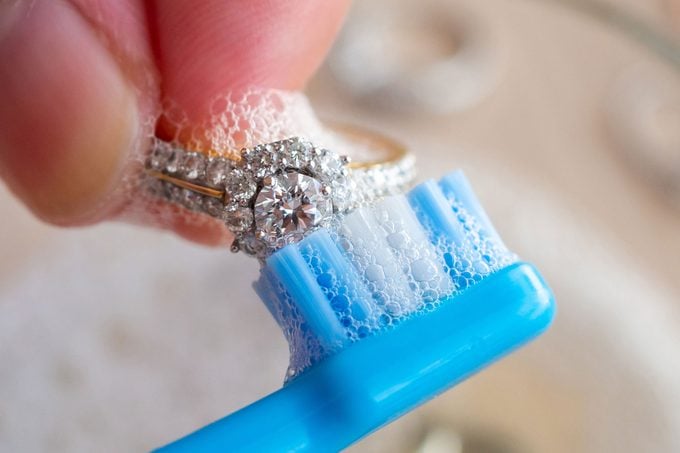
Nothing beats the brilliance of a diamond—unless that stone is covered in hand cream, sunscreen, hair gel, cookie dough … the list goes on. While you could purchase an ultrasonic cleaner or pen, I’ve been using this method for years, and it works like a charm. It’s also safe for lab-grown and fracture-filled diamonds.
Remember that while diamonds are durable, that doesn’t mean their settings are steadfast. When cleaning, inspect your piece carefully to check for damage, and if anything seems off, head to your jeweler for a repair. If you want that just-left-the-jewelry-store dazzle, try the cleaning method below as often as daily.
This is the standard method for most jewelry cleaning—not just diamonds—so let’s get comfortable with it.
Supplies you’ll need
- Dawn dish soap
- Bowl of water
- Baby toothbrush
- Microfiber cloth
Step 1: Soak
Add about a teaspoon of dish soap to your bowl filled with water. The dish soap is a surfactant that will help break dirt off the surface of the jewelry, and we’re using a basic one. Read: no “oxy” component and no hand-softening agents either, which can leave residue behind and may have additives that could affect the metal in the setting. Place your jewelry in the bowl and allow it to soak for 30 minutes.
Step 2: Gently brush
Softly brush the piece with the baby toothbrush, taking a 360-degree approach. Many diamonds have open-back settings, and the stones can look dull quickly when buildup sneaks into those harder-to-reach (and see!) parts. “Our No. 1 tip to our bridal clients is to clean their engagement rings with a baby toothbrush,” says Brown, who creates custom engagement rings. “It’s small and has gentle, superfine bristles that can get into small crevices.” Pay attention to the prongs or channels that hold the stones too; these can hold gunk and buildup that dull the brilliance of your stone.
Step 3: Rinse and dry
Rinse the jewelry well in clean water—you may want to use a separate bowl filled with clean water instead of rinsing it in a sink, as added insurance a piece won’t fall down the drain. My father is an insurance broker, and I have heard my share of stories about diamond rings that have fallen down the sink or toilet—yikes! Once done, place the piece in a cloth and blot it dry.
| ♦ Pro tip |
| When cleaning a ring, I brush with my dominant hand and lock the ring between my finger and thumb on the other. This gives me that all-around access without worrying about the piece falling. When cleaning a bracelet or earrings, I’ll do it inside the bowl for extra security. |
If you love diamonds and jewelry, here are some things you should know that your jeweler won’t tell you.
How to clean gold jewelry
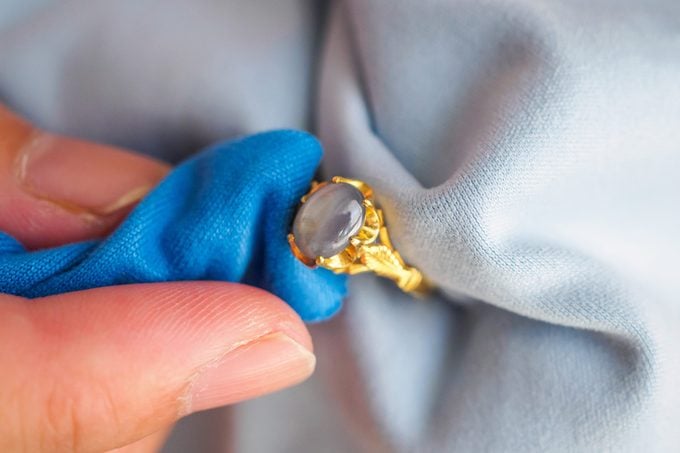
While 24-karat gold is considered “pure,” lower karats of gold are mixed with other metals, typically copper or silver, to increase its hardness. Those mixed-in metals can react with certain chemicals, so cleaning your gold correctly will ensure it sparkles and shines. Another consideration when it comes to cleaning gold jewelry is that the more pure the gold, the more prone it is to scratching, so you’ll want to use gentle cleaning products and methods that aren’t abrasive, especially on higher-quality gold. Whether your piece is rose, white or yellow gold, the cleaning methods are the same.
Supplies you’ll need
- Dawn dish soap
- Small bowl of water
- Baby toothbrush
- Microfiber cloth
Step 1: Soak
Add a squirt of dish soap (about a teaspoon) to the bowl of water. The dish soap is a surfactant, a detergent that can help bring dirt to the surface while breaking down grease and oil. Drop your jewelry in the bowl, and allow it to soak for 30 minutes. This gives the surfactants in the dish soap time to work hard and break down any buildup. This means less elbow grease for you, please and thank you.
Step 2: Gently brush
Brush the crevices of the jewelry with the baby toothbrush. This makes a big difference, since those tiny bristles will dig deep and brush anything stubborn or crusty off—if the piece you’re cleaning has small details, do not skip this step. A baby toothbrush is ideal for the job, because it has soft bristles that won’t scratch even the softest gold.
Step 3: Rinse and dry
When done brushing, rinse the piece well to remove all the soap residue. Place the piece on the microfiber cloth and gently roll to dry.
| ♦ Pro tip |
| If you’re wondering what pressure to use when brushing your jewelry, imagine brushing the inside of your fingernails. You need to be gentle enough not to cause damage or pain, but thorough enough to knock buildup loose. |
How to clean pearls
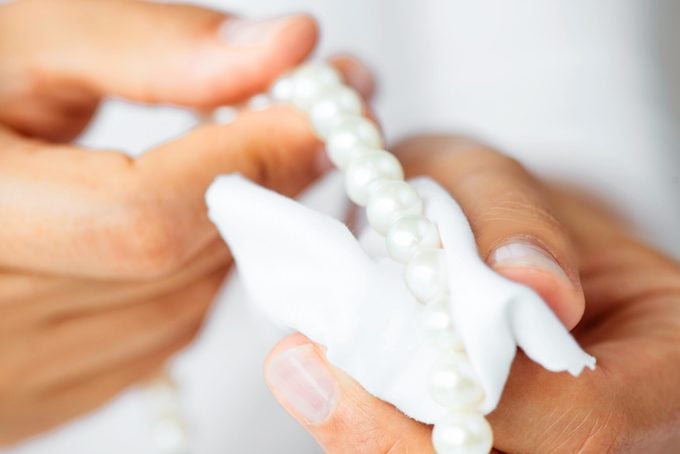
Pearls are soft and notoriously sensitive, making it all too easy to scratch or ruin that famous iridescent finish, also called a nacre. According to the Gemological Institute of America (GIA), pearls can be damaged by many chemicals and most acids. That’s why you’ll want to put your pearls on after you are fully made up and have given any hairspray or perfume you use a few minutes to dry. Then, after you’ve worn the pearls, wipe them with a soft, clean cloth to remove any traces of product; even perspiration can be damaging, according to the GIA. Do not clean pearls using an ultrasonic steam cleaner, as they are far too sensitive.
Supplies you’ll need
- Dawn dish soap
- Bowl filled with water
- Two microfiber cloths
Step 1: Combine soap and water
Mix up a solution of 1/2 teaspoon dish soap to 1 cup water. Dip a cloth into the solution.
Step 2: Clean each pearl
Gently wipe each pearl, inspecting the pearl for damage and the string for any weak points. If you notice any areas of concern, take the piece to your jeweler for repair.
Step 3: Dry the piece
Use a dry cloth to remove any excess moisture, then lay flat on a fresh cloth to dry. Once the thread has completely dried, store the pearls flat in a cloth or jewelry pouch to help maintain the thread’s integrity. Jewelry storage is key when it comes to pearls—keep yours in a cool, dry place, as excessive heat can damage the pearls.
| ♦ Pro tip |
| If your natural pearls have yellowed, try a soft cloth dipped in nail polish remover with acetone to whiten them after cleaning. |
How to clean silver jewelry

If you have any silver jewelry, you know that it tarnishes—gets dark spots—easily. Silver tarnishes simply because of oxidization (a chemical reaction), but silver can be dazzling in seconds when cleaned correctly. If you haven’t worn a piece in a while, be prepared to polish it up. You can purchase silver cleaning polish if your piece has stones or other components like enamel, pearls, clay or other elements that cannot be immersed in the solution below, but for pieces that are simply metal, use the following simple method. I’ve had friends gather around the kitchen table and toss their silver in while I did this to my own pieces because watching this work is so impressive that it’s practically a party trick.
Supplies you’ll need
- Heat-proof bowl
- Aluminum foil
- 2 tablespoons baking soda
- 2 cups boiling water
- Coated tongs
- Microfiber cloth
Step 1: Prep the bowl
Line the bottom of your bowl with a sheet of aluminum foil, then place silver pieces on the aluminum foil. Sprinkle the baking soda on top of the pieces.
Step 2: Soak
Slowly pour boiling water into the bowl to help the baking soda dissolve. You should notice the silver brightening almost instantly. Leave silver pieces in the bowl for two to three minutes, then remove them carefully using tongs (the tong’s coating will help prevent scratching), and lay them onto a microfiber cloth.
Step 3: Dry and polish
Use the cloth to dry the jewelry. In my experience, some tarnish may be left behind, so I’ll dip the cloth into the water and gently polish those spots.
| ♦ Pro tip |
| When not in use, store silver in a soft cloth or jewelry pouch to help keep moisture away and prevent oxidization. |
How to clean costume jewelry
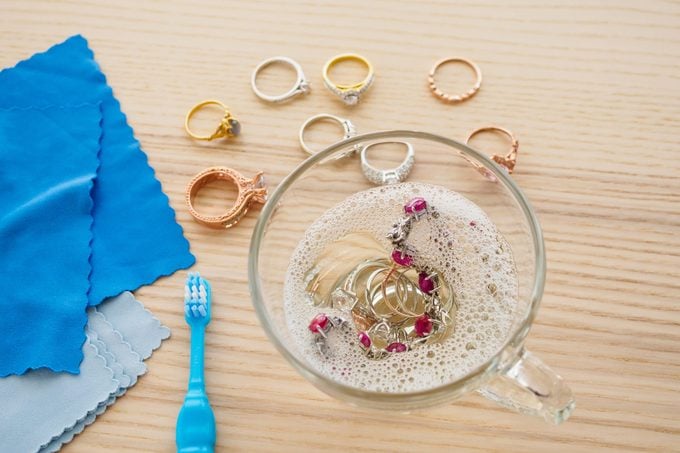
I wear a few costume jewelry bracelets, necklaces and chunky rings on a regular basis. I love the look, but they are the pieces that wear the fastest and show wear if I don’t clean and care for them correctly. Trust me, I’ve had a few expensive lessons in my day. Costume jewelry can be made from several metals, alloys (mixes of metals), beads, stones and more. Generally speaking, the same rules apply for costume jewelry as for other types: Be gentle, keep the pieces free of lotions, sunscreen, cosmetics and perfumes, and clean often to remove sweat, grime, body oil and other buildup.
While some suggest cleaning costume jewelry with an acid, like vinegar, or a mild abrasive, like toothpaste, I do not like either method; they are too risky and can erode metals and coatings. Stick to the basics—agitate the dirt away manually—and you’ll be safe. Please read the care instructions that come with your specific piece; there may be something like a stone or certain metal that cannot be exposed to water, and the manufacturer will know best. Always follow their guidelines first.
Supplies you’ll need
- Dawn dish soap
- Bowl of water
- Baby toothbrush
- Microfiber cloth
- Blow dryer
Step 1: Mix the solution
Add 1 teaspoon of dish soap to the bowl of water and mix with a toothbrush.
Step 2: Gently scrub
Dip the toothbrush and jewelry into the water, gently scrub the piece to loosen any buildup, and rinse with fresh water. Notice how soaking is being avoided here; these metals do not typically do well with water exposure, so we’re looking for a quick-in, quick-out treatment.
Step 3: Dry completely
Dry the piece thoroughly with a cloth. Use a blow dryer to blast away any excess moisture to ensure the piece is dry before storing.
| ♦ Pro tip |
| As an extra precaution with costume jewelry, always remove it whenever showering, sleeping, swimming, washing hands or working up a sweat. Why? The materials used typically contain a higher content of reactive metals and sometimes only a thin coating of gold or silver, called plating, which can scratch or chip easily. |
Jewelry cleaning FAQs
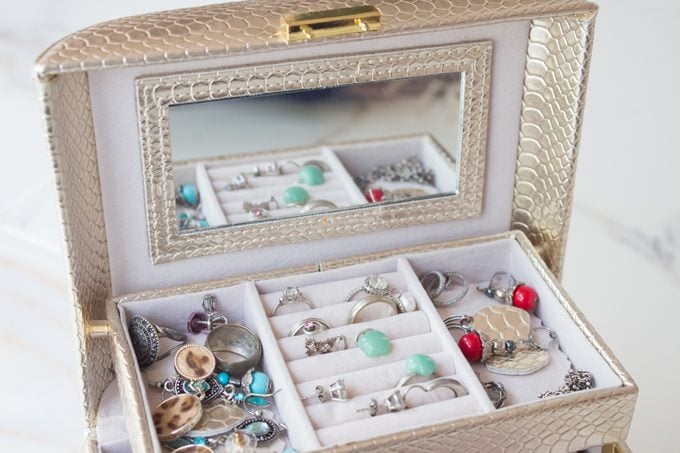
How often should you clean your jewelry?
To figure out how often to clean your jewelry, the first thing to do is look at it! If it looks dull or lackluster, that’s your sign to clean it following one of the methods above. Otherwise, consider the material the piece is made from and how frequently you wear it. If you wear the piece occasionally, clean it after each wear and before storing it away. Remember, buildup on jewelry can lead to discoloration and dullness, so try to wipe it down with a jewelry cloth after each wear. In general, I follow these guidelines:
- Rings and bracelets that are worn regularly get dirty the fastest, in my experience, so I’d clean those weekly.
- Earrings you wear regularly can be cleaned twice monthly—I notice mine get dull from makeup and hair products.
- Necklaces can be cleaned monthly or when you notice they look dingy.
How do you best care for your jewelry?
Always remove your jewelry before going to bed. Not only can rings, earrings, bracelets and necklaces be uncomfortable when sleeping, but they can also pick up sweat and other skin-care products overnight. If you know you’ll be doing an activity, like cleaning, baking, painting or sports, where your pieces can get gunked up, remove your jewelry first. This is also good practice to avoid losing, scratching or damaging a piece.
Proper jewelry storage is also important, since it can prevent tangles, damage and loss and can help reduce oxidization.
What should you avoid cleaning jewelry with?
You might see several things recommended as DIY jewelry cleaners, but as you can see, we’ve kept our instructions extremely simple and gentle. That’s because harsh detergents (for example, laundry detergent), any cleaning solution containing bleach or ammonia or anything overly abrasive can ruin the fine finish of your jewelry. I’ve also kept the tools very simple; a baby toothbrush ensures the pieces won’t be scratched, and microfiber cloths will dry the pieces quickly without scratching them.
Can you clean jewelry with rubbing alcohol?
According to Brown, it’s fine to clean diamonds and gold jewelry with rubbing alcohol. To clean pearl, silver, gemstone or costume jewelry earrings between uses, it’s safe to clean posts and backings with an alcohol swab. However, keep the alcohol off the rest of the piece, because rubbing alcohol can dry out delicate elements or ruin a finish.
Can you clean jewelry with vinegar?
While I do not recommend cleaning your jewelry with vinegar, because the acid can affect the metal in costume jewelry, others do. According to Brown, “Vinegar, mild soapy water, isopropyl rubbing alcohol are all safe cleaning chemicals that, when used gently, can efficiently clean your (fine) jewelry.” To be clear, these agents can be used individually to clean pieces, not mixed together. I like to keep things simple, so when in doubt, choose a gentle dish soap that will break down dirt and oils and leave you with a clean piece.
Is it OK to shower with jewelry?
Brown says it’s OK, but not ideal, to shower with diamonds, gold or silver jewelry, but pearls, opals, gemstones such as green emerald, and costume jewelry are too delicate for the shower. He cautions that the residue left behind from soap, shampoo and body scrubs can dull the luster of these stones.
Now you know how to keep your jewelry sparkling, clean and safe for years to come!
Why trust us
At Reader’s Digest, we’re committed to producing high-quality content by writers with expertise and experience in their field, in consultation with relevant, qualified experts. For this piece, Stephanie Sisco tapped her experience as a longtime home and cleaning editor. Then Ann Russell, TikTok’s “cleaning auntie” and the author of How to Clean Everything, gave it a rigorous review to ensure that all information is accurate and offers the best possible advice to readers. For this piece, we relied on reputable primary sources, including cleaning and faucet experts and reputable organizations. We verified all facts and data and backed them with credible sourcing, and we will revisit them over time to ensure they remain accurate and up to date. Read more about our team, our contributors and our editorial policies.
Sources:
- Jared Brown, founder of Jared Brown Fine Jewelry; email interview, Jan. 20, 2024
- World Gold Council: “Is Gold Jewellery a Good Investment?”
- Gemological Institute of America: “Pearl Care and Cleaning Guide”
